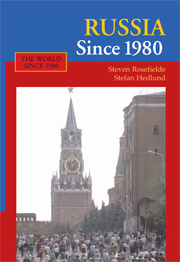Book contents
- Frontmatter
- Contents
- List of Figures, Tables, and Boxes
- Acronyms
- Timeline
- Preface
- Acknowledgments
- Introduction
- PART I RUSSIA BEFORE 1980
- PART II GORBACHEV
- PART III YELTSIN
- 6 Demolition and Systems Building
- 7 Crisis Management
- PART IV PUTIN
- PART V ADVANCE AND RETREAT
- PART VI PROSPECTS
- Conclusion
- Glossary
- Bibliography
- Index
- References
7 - Crisis Management
Published online by Cambridge University Press: 05 June 2012
- Frontmatter
- Contents
- List of Figures, Tables, and Boxes
- Acronyms
- Timeline
- Preface
- Acknowledgments
- Introduction
- PART I RUSSIA BEFORE 1980
- PART II GORBACHEV
- PART III YELTSIN
- 6 Demolition and Systems Building
- 7 Crisis Management
- PART IV PUTIN
- PART V ADVANCE AND RETREAT
- PART VI PROSPECTS
- Conclusion
- Glossary
- Bibliography
- Index
- References
Summary
Order of Economic Liberalization
Russia's post-1986 odyssey is the saga of the Kremlin's passage from an authoritarian Reform Communist physical management system to authoritarian Market Muscovy, with many seemingly portentous subplots that aren't. Most analysts for diverse reasons wanted to believe that Mikhail Gorbachev, Boris Yeltsin, and Vladimir Putin were engaged in a struggle to construct democratic free enterprise or social democracy in the land of Rus and scripted their narratives accordingly. Their stories were studded with wicked communists, the VPK, secret police, and reactionary chauvinists conspiring to restore autocracy and central planning and valiant democrats such as Gorbachev and Yeltsin determined not to let this happen. The battlefield was liberalization and transition. Villains strove to preserve the old order by urging gradual marketization, while westernizers insisted on shock therapy as the only sure way of breaking with communism. They demanded the immediate dissolution of the Communist Party and the termination of central planning, ministerial directives, guaranteed enterprise sales, state contracts, state-funded managerial bonuses, state ownership, price and exchange rate fixing, the monopoly of foreign trade and banking, as well as VPK and KGB economic oversight, arguing that dislocations would be surmounted by the invisible hand and expert western advice and assistance. Academician Stanislav Shatalin envisioned full transition in 500 hundred days, while others forecast a shallow recession swiftly reversed by ascending the J curve. But this wasn't essential.
- Type
- Chapter
- Information
- Russia Since 1980 , pp. 108 - 136Publisher: Cambridge University PressPrint publication year: 2008

